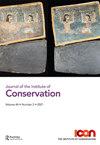A review of selected drilling methods used to de-concrete cast iron, smoothbore, marine archaeological artillery
IF 1
0 HUMANITIES, MULTIDISCIPLINARY
引用次数: 2
Abstract
Abstract The removal of concretion from the bores of cast iron, marine archaeological artillery represents an unusual mechanical problem for conservators. While the exterior may be cleaned like any other concreted iron object, the interior has extremely limited access. Specialised tools are therefore required to remove this concretion. Over the last several decades, many laboratories which regularly clean artillery have developed methods using coring drills for this process, sometimes supplemented with other tools. The exact drilling apparatus and operating methods vary widely, since multiple conservation laboratories have developed unique systems for this process and each operates under different constraints and towards different specific goals. This article serves to publish some basic design elements for different artillery boring assemblies. In describing different methods, comparisons are made with respect to the goals, constraints and priorities which produced a given design. The benefits and drawbacks of those designs are then evaluated.用于混凝土铸铁、滑膛、海洋考古火炮的选定钻孔方法综述
摘要:从铸铁孔中去除混凝土,海洋考古火炮代表了一个不寻常的机械问题。虽然外部可以像任何其他混凝土铁物体一样清洁,但内部的进入非常有限。因此,需要专门的工具来去除这种结痂。在过去的几十年里,许多定期清理火炮的实验室已经开发出使用取心钻头进行这一过程的方法,有时还辅以其他工具。确切的钻井设备和操作方法差异很大,因为多个保护实验室已经开发了独特的系统,每个系统都在不同的约束条件下运行,朝着不同的特定目标运行。本文介绍了不同火炮钻孔装置的基本设计要点。在描述不同的方法时,对产生给定设计的目标、限制和优先级进行比较。然后评估这些设计的优点和缺点。
本文章由计算机程序翻译,如有差异,请以英文原文为准。
求助全文
约1分钟内获得全文
求助全文
来源期刊

Journal of the Institute of Conservation
HUMANITIES, MULTIDISCIPLINARY-
CiteScore
1.50
自引率
0.00%
发文量
22
期刊介绍:
The Journal of the Institute of Conservation is the peer reviewed publication of the Institute of Conservation (Icon). As such, its aims reflect those of Icon, to advance knowledge and education in conservation and achieve the long term preservation and conservation of moveable and immoveable cultural heritage. The Journal provides a collective identity for conservators; it promotes and supports both the profession and professionalism. With international contributions on all aspects of conservation, it is an invaluable resource for the heritage sector. The specific aims of the Journal are to: 1. promote research, knowledge and understanding of cultural heritage conservation through its history, practice and theory 2. provide an international forum to enable and disseminate advances in research, knowledge and understanding relating to conservation and heritage 3. champion and support professional standards of heritage conservation in the UK and internationally 4. provide a permanent record of issues relating to conservation and heritage 5. be financially and operationally sustainable. To achieve these aims, the Journal invites contributions from all those involved in the conservation of cultural heritage and related activities. Areas of interest include understanding cultural heritage materials and their degradation; subject reviews and histories of cultural heritage materials and conservation treatments; new, innovative or improved approaches to conservation and collections care theory, practice, communication, management and training; case studies demonstrating new, innovative or improved approaches; and conservation in its wider context. Submitters are encouraged to demonstrate how their work is of practical application to conservation. To maintain professional standards and promote academic rigour, submissions of articles and shorter notices are subject to an anonymous peer review process.
 求助内容:
求助内容: 应助结果提醒方式:
应助结果提醒方式:


